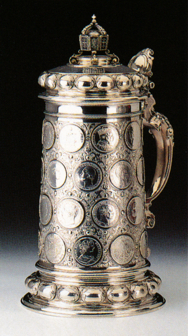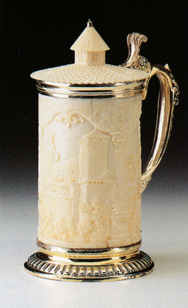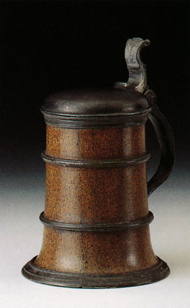|
Stein Collectors International |
The Rastal Collection of
Historic
Drinking Vessels
A concise guide to the Rastal Collection, its epochs and its trends in
style.
This content of this article is taken from a pamphlet published by RASTAL GMBH&CO.KG.
Rastal has created a communication centre - the Rastal Gallery - in the West German town of Höhr-Grenzhausen. In this gallery, the collection is presented in large-scale display cases. For all forms of events, facilities are available in the adjacent Rastal seminar centre. These rooms are to be found within Rastal's administration building and their design is orientated on its striking hexagonal architecture.
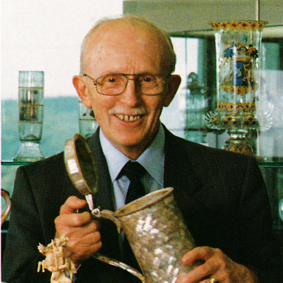 The basis of the Rastal collection, one
of the most important and largest of its kind worldwide, encompasses
several thousand examples of drinking vessels in ceramics, glass,
pewter, silver, wood and other materials. In time, it spans all epochs
from the time of the Roman Empire to the present day.
The basis of the Rastal collection, one
of the most important and largest of its kind worldwide, encompasses
several thousand examples of drinking vessels in ceramics, glass,
pewter, silver, wood and other materials. In time, it spans all epochs
from the time of the Roman Empire to the present day.
The "Rastal Collection of Historic Drinking Vesels" was founded and expanded by the company's co-owner, Werner Sahm-Rastal [now deceased]. Based on his intensive acivities as a collector and his expert theoretical engagement with the subject, he is today an expert who has lively contact to specialists throughout the world.
A selection of some 500 items is on display, put together according to the criteria of originality, techniques, value and characteristics of areas of origin. Above all, the exhibition offers Rastal customers within the drinks industry stimulus for the manufacture of drinking vessel replicas. The much admired pieces are highly regarded as presents at company jubilees, celebrations and on many other occasions. But the collection also serves Rastal designers as a valuable mine of ideas for correct style in new creations.
This article contains several German terms which have significant historical or technical meanings, so they are defined here.
Application -
Clay reliefs: either free-formed or from negative moulds attached to
the vessel by means of a thin clay slip before baking.
Body -
Unglazed ceramic mass after baking.
Clay glazing
- Simple glazing of clay or slip in order to make ceramics imperious
and to achieve a regular brown colouring.
Cutting -
Working of the glass surface with rotating stone discs. The rounded
survace is divided into angled sections, producing patterns with
increased refraction.
Earthenware
- Reduced-temperature-baked ceraic with porous body usually known as
peasant pottery, made impervious by lead glazing.
Enamel painting
- Painting with glass flux coloured by metal oxides on clay, glass or
metal.
Engobe - A
glaze
coating on ceramic vessels consisting of a clay slip applied either by
dipping, sprinkling or my means of a brush. (This term is also used as
a
verb.)
Engraving -
By means of small rotating copper discs of various dimensions down to
the size of a pinhead, matt ornamental designs or pictures are engraved
into the surface of the glass.
Fience - A
porous ceramic baked at temperatures up to around 1,200C degrees, made
impervious by opaque white tin glazing.
Forest glass
- Made in the areas of widely-forested, medium altitude mountains, has
a greenish or brownish tone produced by the iron contained in the sand
used.
Humpen -
Cylindrical or slightly bellied drinking vessel, the base having almost
the same diameter as the rim.
Jug -
Vessel designed for pouring liquids, with spout, nozzle or beak.
Knibis
Decoration - Zig-zag patterns made with a wide, flat wooden stick in a
rocking, see-sawing motion, impressed in the unbaked ceramic body.
Krautstrunk
(cabbage stalk) - Medieval drinking vessel, its form and the appolied
burls having similarity to a cabbage stalk without leaves.
Layered or flashed
glass
- is made by a glass blower, working at the furnace. One or more layers
of different coloured glass are added to an initial piece [gather]
before being blown as one.
Opal or milk glass
- White, non-transparent glass made by adding bone ash or stannic oxide
to the mass.
Oxidizing baking
- A baking technique producing stoneware with a brown surface. The
feeding of oxygen combined with high temperature causes oxydization of
the iron content of the stoneware surface.
Passglas
- Stemmed glassess with applied horizontal glass rings. During the 16th
and 17th centuries these glasses were specially popular for drinking
games. The rings act as markings for the drinker, who according to
calls had to drink a specified quantity of liquid determind by a level
set between two rings.
Peacock-eye decor
- Decoration technique with which the colour is appied with a small
sponge. Best known on Bunzlau stoneware, the technique is also used in
Faience manufacture.
Pinte -
Narrow, conical jug similar to the Schnelle but smaller.
Pulle
(dialect: bottle) The Pulle was manufacured during the 16th century,
predominantly in Siegburg. It embodies both jug and bottle forms. The
vessel has rounded body with a flat base and a short high-lipped
narrow neck.
Red
(scored)-decoration - This design is made by scoring with pointed
wooden sticks often combined with cobalt or manganese coloring.
Reduction baking
(firing) - Baking tehnique producing grey or white stoneware.
After salting and at the highest temperature the furnace-oxygen feed is
stopped.
Salt glazing
- Glassy coating on stoneware. At the highest temperature, salt is
shovelled into the furnace, sodium oxide combines with the ceramic
silicates in the body.
Schnelle -
High, conical jug.
Although characteristic of Siegburg, also manufactured in other Rhenish
stoneware centres (except Westerwald) Origin of the name is unknown.
Sintering -
Vitrification of ceramic during baking in the furnace. Stoneware
sinters at c. 1,250C degrees, the ceramic thus becoming impervious to
water.
Smalt -
Clay slip with high flux content and cobalt or manganese used as
under-glazing colouring matter.
Staining -
Substances containing metal oxides, applied to glass surfaces by means
of a brush in chiefly yellow and red tones. The stains are stoved at
temperature of 600-650C degrees and can afterwards be cut or engraved.
Silver compounds produce yellow, copper compounds red tones.
Stoneware -
Ceramic products with hard fritted body, impervious to water when
unglazed, cannot be scored or cut with steel, acid-proof baked at 1200
to 1300C degrees.
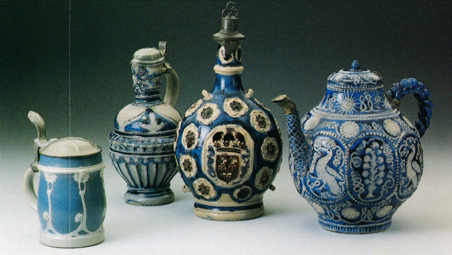 WESTERWALD STONEWARE
WESTERWALD STONEWARE
The pot bakers region (Kannenbäckerland) with the town of Höhr-Grenzhausen at its centre, lies in the southwest of the Westerwald. It is almost certain that the manufacture of ceramic wares was carried out here even in pre and early historic times. Stoneware of high standard craftsman-ship was produced toward the end of the 16th century as the local craft blossomed under the influence of immigrant potters.
Left
to right: Beer tankard, early 20th C.;
Small jug, early 17th C.; Pilgrim bottle, dated 1665; Teapot, 2nd half
18th C.
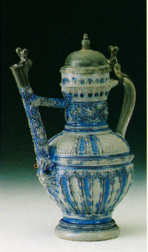 |
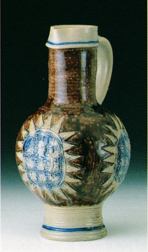 |
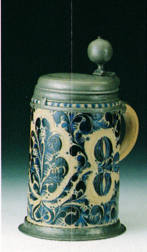 |
 |
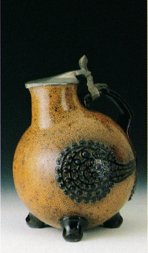 |
| Spouted
jug, dated 1594 Late Renaissance (End 16th/Early 17th C.) This time marks the beginning of a period of excellent stoneware craftsmanship. Characteristics of style are the salt-glazing of the ceramic with cobalt-blue painted decoration and precise vertical patterning on the vessels. Friezes of human figures are the most common decoration. |
Narrow-necked jug, dtd. 1680 Baroque (Mid-17th/Early 18th C.) Vessels were thrown on the wheel in one operation, resulting in forms appropriate to the material. New forms are round, pot-bellied and pear-shaped jugs. In addition to cobalt blue the new color manganese violet emerges. Decoration consists of smaller applied elements often scattered on the walls of the vessels. |
Beer
tankard, lid dated 1737 Late Baroque/ Transitional (mid-18th/ Early 19th C.) Ornamentation on the vessels is now in the more popular style. Applied decoration becomes rarer, score and "Knibis" patterning come into the forefront. Toward the end of the 18th century the quality of craftsmanship declines. |
Beer
boot, late 19th C. Historicism (Mid-Late 19th C.) Growing nationalism awakes interest in "national" styles. The tendency is toward historical forms and ornaments, vessels are made as replicas of former examples or are designed in the style of past epochs, for example, the Renaissance. New techniques make exactness of execution and higher quantities possible. |
Pot-bellied
jug, c. 1910 Art Nouveau (Early 20th C.) The Art Nouveau style was the artistic reaction to overloaded historicism. Influenced by Japanese art, the trend is toward ornamentation based on forms of nature. Experiments with new types of glazing are carried out. Stoneware manufacturers engage famous designers, for example, Richard Riemerschmid, van de Velde, Behrens and Wynand. |
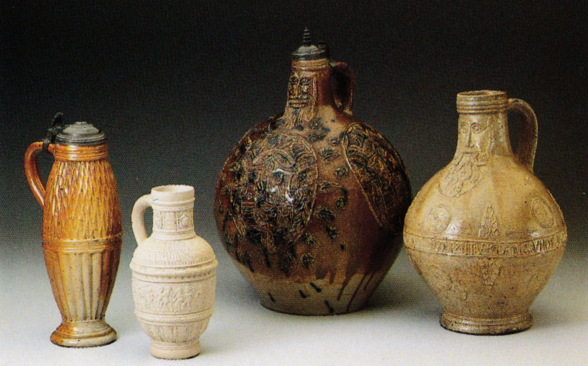 RHENISH
STONEWARE CENTRES
RHENISH
STONEWARE CENTRES
Left
to right:
Raeren, beer tankard, 2nd half 16th C.
Siegburg, peasant dance jug, dated 1589
Frechen, bearded-man jug, early 17th C.
Cologne,
bearded-man jug, mid 16th C.
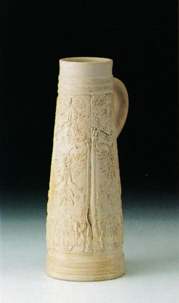 |
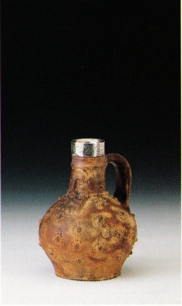 |
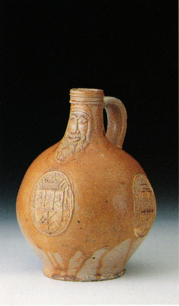 |
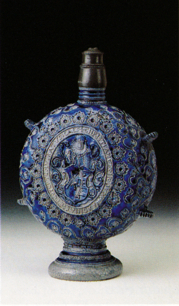 |
| "Schnelle" dated 1591 | Bearded-man jug, mid-16th C. | Bearded-man jug, early 17th C. | Pilgrim bottle, early 17th C. |
| Siegburg Potter craftsmanship blossomed in the 16th century. Characteristics are the white to yellow ceramic body and the artistic applied decoration. Preferred vessel forms were "Schnellen," bottles and jugs. In the late 16th century, members of the leading family of potters, the Knütgensw, emigrated to the Westerwald. |
Cologne Cologne is believed to be the first centre where salt glazing was carried out on a regular basis. In the early 16th century the Cologne pot bakers were trend-setters. Typical forms: "Pinten," "Schnellen" and bellied tankards , with brown engobe and applied decoration. A bearded face applied to the neck of many bellied vessels gave these their name bearded-man jugs. Around the middle of the 16th century the pot bakers were forced to leave the city. |
Frechen Frechen products are often difficult to distinguish from those of Cologne as many pot bakers who were forced to leave that city settled here. Favoured vessel forms were very large bellied-jugs decorated with bearded masks on the necks and with applied coats of arms. |
Raeren Raeren lies close to Aachen but today belongs to Belgium. Stoneware began to blossom in the second half of the 16th century, touched off by examples from Cologne and Siegburg. Initially it was produced with a brown surface. In the second half of the 16th century reduction-baking was perfected, through which the body remained grey. A specialty of the Raeren potters was the application of pictures created by outstanding artistic potters At the end of the 16th century many Raeren potters settled in the Westerwald region. |
 CENTRAL
AND EASTERN GERMAN STONEWARE CENTRES
CENTRAL
AND EASTERN GERMAN STONEWARE CENTRES
Left
to right:
Waldenburg,
beer tankard, dated 1879
Annaberg,
screw-top bottle, 2nd half 17th C.
Muskau, pear-shaped jug, lid dated 1699
Bunzlau, small milk jug, 2nd half 18th C.
Altenburg,
beer tankard, c. 1630/40
| Apart from the Rhenish centres, excellent stoneware was produced very early on in locations in Saxony/Thuringia, in Lusatia and Sillesia. In particular Waldenburg, whose potters' guild foundation charter dated 1388 still exists, deserves a similarly high placing to that which Siegburg in Western German enjoyed. The development of stoneware in central and eastern Germany took place largely independently. The quality of craftsmanship is equal to that of the Rhenish masters. | 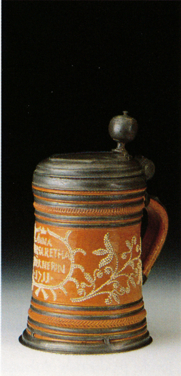 |
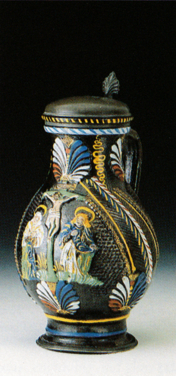 |
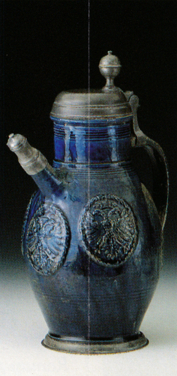 |
| Pearl jug, dated 1711 Altenburg This town lies south of Leipzig, production of stoneware began around 1625. Of the diverse stoneware products, the cylindrical jugs are of particular interest, their decoration giving them the name "pearl-tankards." The ornamentation, often with folk art motifs, is made up of small applied pearl-like shapes formed from a clay mixture which burns out white. |
Pear-shaped jug, c. 1680 Annaberg Annaberg, situated south of Karl-Marx-Stadt (Chemnitz) is better known as a mining town. Manufacture of the blackish brown engobed ware began in the early 17th century. As many of these tankards and jugs were colourfully enamelled, they are often mistaken for Creussen stoneware. Typical are applied friezed of C-arches and finials which encircle the neck or base zone, as well as palmette application on the pear-shaped jugs. |
Spouted jug, 2nd half
18th C. Bürgel/Zeitz Bürgel and Zeitz are two Thuringian pottery centres whose products are difficult to distinguish from each other. Spouted jugs are common. Colouring of the stoneware cn be compared to that of the Westerwald products. The blue tone was however achieved by cobalt smalt being thrown onto the ware during baking, whereby the characteristic runnning-colour effect arose. |
|
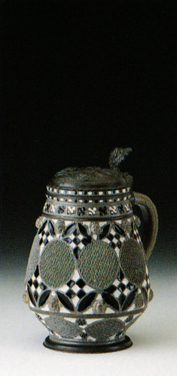 |
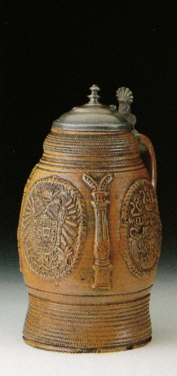 |
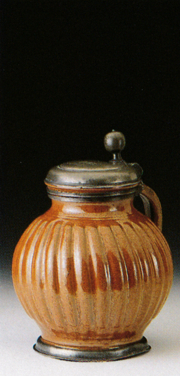 |
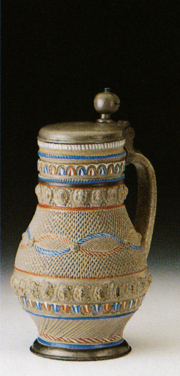 |
| Egg-shaped
jug, c. 1660/70 Freiburg As far as is known, stoneware was manufactured only during the 17th century in this Erzgebirge city. In the first half of the century mainly blackish brown engobed pieces were produced, whereas grey stoneware with fine network patterns painted with enamel colours and gilded, became characteristic for Freiberg in the second half. |
Beehive
jug (tankard), 17th C. Waldenburg Waldenburg is the oldest stoneware pottery centre in central Germany. A rich variety of forms developed. Characteristic in the 16th/17th centuries was the beehive jug decorated by means of roller dies and with excellently executed applied religious motifs or coats of arms. In the 17th century, the brown colour of the stonware was producd by oxydizing baking of the salt-glazed ceramic body. |
Melon-shaped
jug, lid dated 1705 Bunzlau In this lower Silesian town, now a part of Poland, pottery craftsmanship has a centuries-old tradition. As the clay did not frit at high temperatures the result was a brown glazing occasionally tinged green or blue. Typical were melon and pear-shaped jugs, the latter often with white applied decoration. In the 2nd half of the 19th centuiry the "peacock-eye" decor emerged, which is still popular today as a decoration on Bunzlau ceramics. |
Pear-shaped
jug, c. 1660/70 Muskau In the home town of Prince Pückler in Upper Lusatia on the Neisse, pottery workshops were established in very early times. Predominating vessel forms are egg or pear-shaped jugs, spouted jugs and screw-top bottles. There was an extremely rich range of decoration. Almost all vessels are characterised by slanting or vertical goove patterns on their lower halves. |
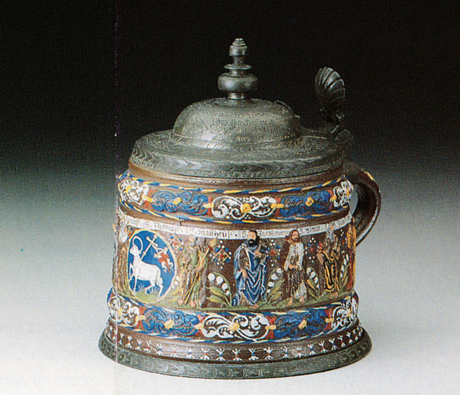 OTHER
STONEWARE CENTRES
OTHER
STONEWARE CENTRES
Creussen
This pottery centre has been renowned since the early 17th century. Its
stoneware rodeucts always have a brown surface rought about by baking
with pine-wood and are glazed with a black salt. Decoration with
applied reliefs was common right from the start. These splendid
vessels, painted by former glass stainers in bright enamel colours,
were much sought after. The enamel-painted tankards with applied
apostle figures or planetary allegories are among the splendours of
stoneware.
At right: -
Apostle tankard, lid dated 1662
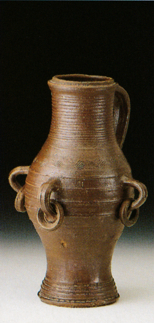 |
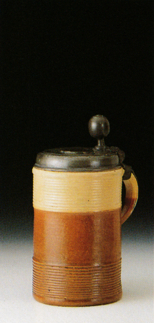 |
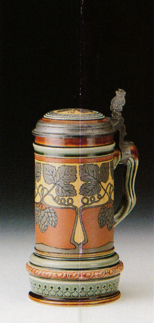 |
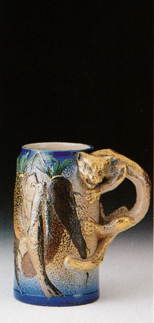 |
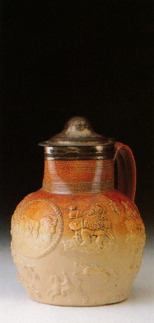 |
| Ringed jug, lid dated
1705 Dreihausen Here in Hesse, close to the city of Marburg, stoneware has been produced since the 15th century. Characteristic is the reddish to violet brown half-matt surface finish of the vessels, achieved by means of a ferriferous engobe. A typical form is the high-shouldered pear-shaped jug which is sparsely decorated with patterns made by roller dies and sometimes with rings attached by loops. |
Beer tankard, lid dated
1751 Duingen There is proof that stoneware manufacture has taken place in this Lower Saxony location close to Alfeld, since the 15th century. In the main, cylindrical jugs with two areas of grooves were produced, some were engobed entirely brown or had yellow patterning on their upper surfaces. In the middle zone, a few have narrow, encircling applied decoration. |
Beer tankard, 1902 Mettlach In the "faiencery" founded by Jean-Francois Boch in 1809 stoneware has been produced since 1843. The most important development in decor was chromo-lithography, a colour-printing process introduced in 1859. Blackened grooves, optically emphasizing the drawing, separate evenly coloured areas. Scenes with rich contents, landscapes, etc. could be decoratively achieved. This technique contributed greatly to the high popularity of the Mettlach tankards. |
Beer tankard, early
20th C. Saargemünd The Loorraine town of Sarreguemines has a rich tradition in ceramics. A specialty are the stoneware vessels from around 1900, whose grey ceramic is stained blue at the edges. Beer tankards often beare scenes in relief on the body as well as handles in animal forms. As well the characteristic blue tone they are someimes colour painted or gilded. |
Beer jug, 1st half 19th
C. Doulton/England Typical of the Doulton ceramic workshops in London since 1820 is beige bodied stoneware, with half the surface engobed dark brown. The walls of the vessels are decorated with small applied reliefs. |
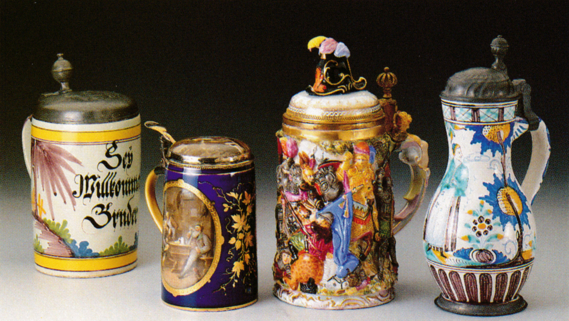 PORCELAIN AND FAIENCE
PORCELAIN AND FAIENCE
Left
to right:
Faience
tankard, Hannoversch- Münden, early 19th C.
Porcelain
tankard, Dresden, late 19th C.
Porcelain
tankard, Plaue, late 19th C.
Faience wine jug, lower Austria, 18th C.
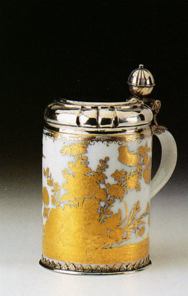 |
| Beer
tankard, Meissen, 2nd half 18th C. |
The European method of manufacturing hard-glazed porcelain was created by Johann Friedrich Böttger and Walter Ehrenfriedvon Tschirnhaus in Meissen in 1708/9. Porcelain is a ceramic produced from kaolin (china clay) and feldspar with other additives. The mass frits whille baking and becomes absolutely impermeable. In the 18th century the whiteness of porcelain was considered a criterion for pureness and excellence. This greatly increased the brilliance of its coloured painted decoration. In the 19th century the white area was predominately used as a background for full decoration or complete colour glazing.
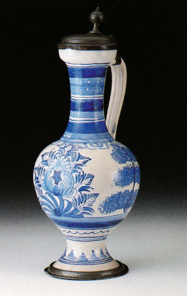 |
|
Narrow-necked
jug, Bayreuth,
mid 18th C. |
Faience is earthenware with a porous unglazed body coated with an impermeable opaque stannic oxide glaze. The earliest Faience pieces were made in Persia around 500 B.C. The manufacturing technique accompanied the Islamic culture to Moorish Spain. Then after moving via Majorca to Italy and in the 16th century into Northern Europe, it was given the name Faience, after the Italian town of Faenza. In Germany, more than 80 Faience factories were founded in the 17th and 18th centuries, the earliest in Frankfurt and Hanau.
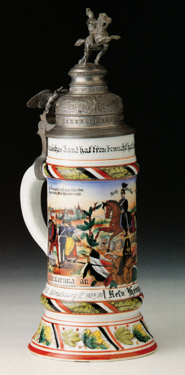 RESERVIST
ARTICLES
RESERVIST
ARTICLES
The majority of the
so-called reservist
tankards date from the turn of the century. On release from the
Imperial German Army, almost every soldier ordered a tankard—usually
porcelain—as a memento of his service days. These tankards are
decorated with colourfully painted manoeuvre scenes, portraits, or
writing. The vessels are crowned with richly formed pewter lids, often
with a decoration referring to the unit in which the soldier had
served. As well as tankards there were also reservist pipes, cups and
plates.
Right: Tankard - Reservist Heinze, southern Germany
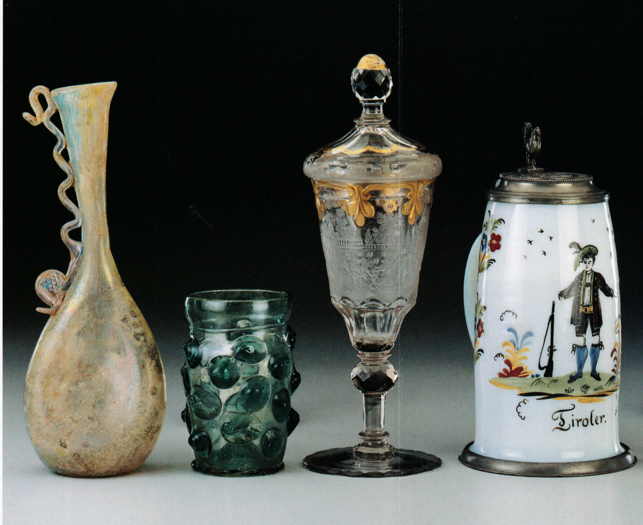
GLASS
Left to right:
Flask, probably Syria, 2/3 C. A.D.
"Krautstrunk" Germany, 15th C.
Lidded goblet, Warmbrunn, c. 1750/60.
Opal glass tankard, probably Austria, c. 1800
Roman glass
The Romans learned the art of glass
making in the Near East. After the
invention of the glassmakers' blowpipe in the 1st century B.C.,
glassware manufacture flourished during the time of the Roman Empire.
Apart from Syria, Roman Cologne was an important glass manufacturing
centre.
The cloudiness and irridescent effects in ancient glasses are due to
chemical changes which have occurred during the long time the glass has
been buried.
Forest glass 16/17th C.
Works producing large quantities of
glassware became common again only in the late middle ages. Apart from
the various types of sand used as raw material, the forest glass works
were primarily dependent on wood for the production of potash and as
fuel. When the forest surrounding the site had been used up, the works
were removed to another location. One of the most interesting
developments in this pierod was the "Krautstrunk" (cabbage stalk), the
forerunner of the so-called "Roman" (hock glass), today's most common
wine glass.
Baroque glass
Somewhat simplified, the Baroque period
(17/18th C.) can be described as the period of engraved glass. Bohemia
produced a pure thick-walled glass with a hardness particularly
suitable for engraving. Initially Nuremberg and Bohemia were leaders in
this technique, but in the 18th century Silesia in particular set the
artistic standards.
Popular glass
Early German glasses—from the first
half of the 16th century—bear motifs from the picturesque world of folk
art. In bright enamel colours, scenes of family-life, love and erotica
are depicted as well as subjects from the animal and plant world.
Greetings and wishes accompanied by appropriate symbols are also to be
found.
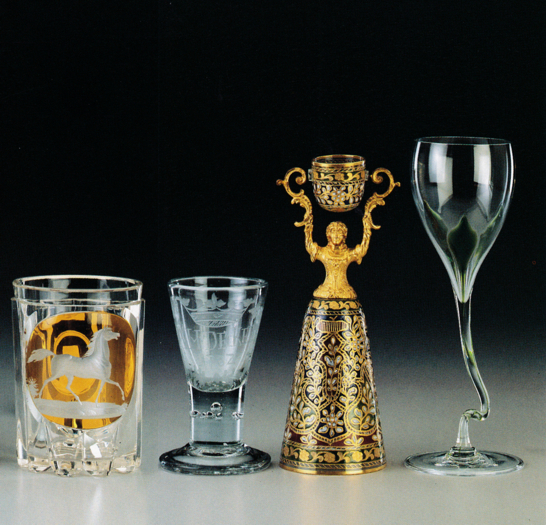
Left to right:
Beaker, northern Bohemia, c. 1840/50
Spirits goblet, north Germany, dated 1782
Bridal cup, Petersdorf, c. 1890
Wine glass, Cologne-Ehrenfeld, early 20th C.
Biedermeier glass
In the first half of the 19th century
the craft of glassmaking reached an absolute high point. This was above
all due to the dedications of the Bohemian glass works and artists.
Biedermeier cut-glasses are still regarded as admirable examples of the
artistic art of glass cutting. The cut and form of the glass influence
each other. But the standard of engraving and glass painting was also
high. Thanks to the experimental enthusiasm of the numerous Bohemian
glassworks, a great variety of coloured glasses was also produced.
Since then there has never been such a rich and various range of
colours in glassworks.
New glass forms
Toward the end of the 18th century the small, mostly weighty and
somewhat crudely formed spirits glass came into use. Its form derives
from the goblet, having usually a conical cup on a massive stem and
heavy base plate. Small goblets continued to be used for spirits and
liquors.
Historicist glass
In the 2nd half of the 19th century,
designers - also those of glassware - returned to the styles of past
epochs. This was a time of advancing industrialization, oriented
principally toward mass production, which hindered development of a
specific independent style. Designers fell back on classical examples
in an attempt to arrive at a contemporary style. In this way, in
addition to pure reproductions, a wealth of glassware of high artistic
craftsmanshp was created which is the equal of that of earlier epochs.
Art Nouveau glass
Around 1900, new, fresh and unique
forms of expression were sought in the applied arts. It was no longer
sufficient simply to refer to historic forms. Inspired by the colours
and wealth of Asian forms, glass vessels with strikingly rich
decoration and a wide variety of colours were produced. Exemplary are
the works of Louis Comfort Tiffany and Emile Gallé. But also the more
practical, everyday drinking vessels from glassworks of the Bavarian
forests or the Rhineland with their pleasing forms and lightness are
still attractive today.
